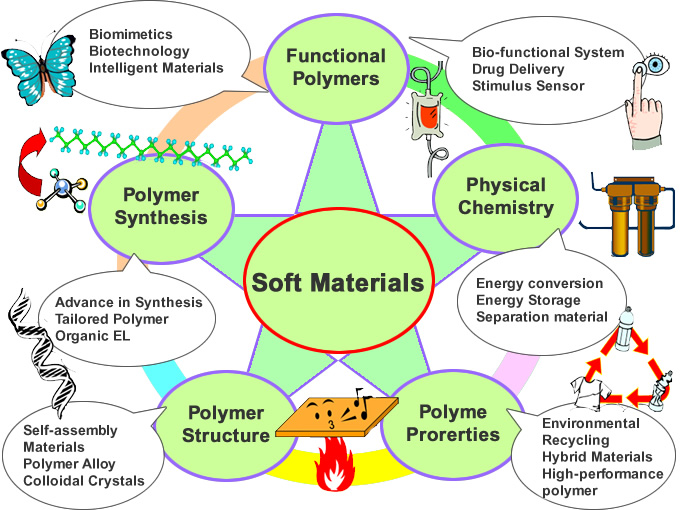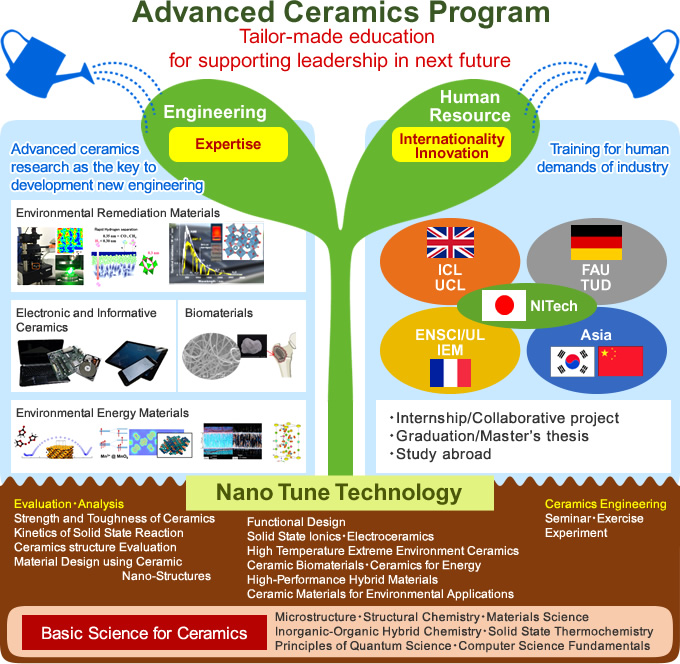
Bird's-eye View
Life and Materials Chemistry
In this division, the inherent properties of chemical substances are examined from the perspectives of synthesis, characteristics, and reactions at the atomic and molecular levels. In this regard, analytical and physical chemistry looks at isolation and analysis of substances, structural analysis of their constituent atoms and molecules, and their assembly and physical properties. Inorganic chemistry and chemical engineering explores the structure of inorganic substances, and reactions and energy conversion processes. Organic and polymer chemistry involves research into organic synthesis, organic substances, and functional substances. Specialized fields accommodate comprehensive educational and research programs. A specific goal is engineering of specialized biological functionality. The principal field of research concerns biomolecules, and focuses on conversion processes and self-assembly at the molecular level, with the goal of producing artificial supramolecular systems (such as enzymes, biocompatible materials, sensors, and artificial proteins), design of biomimetic and associated bio-inspired systems, and ultimately, the creation of artificial life.
Soft Materials
Organic materials constitute one of the most important groups of components that support human life in the 21st century. Beyond structural materials typified by general-purpose plastics and synthetic fibers, polymer materials that exhibit high performance and functionality are of very great interest. These include materials that have a large impact on human life, such as biomaterials for artificial organs and drug delivery systems, biomimetic materials for use in devices such as light sensors, environmentally compatible materials such as biodegradable polymers, and functional polymers that support the IT industry or are applicable to organic electroluminescent elements and photoresists. In addition, molecules such as proteins and nucleic acids in our bodies spontaneously self-assemble and form regulated structures that give rise to the sophisticated functionality required for life. The ability to design such polymer compounds at the atomic level and achieve molecular level control of highly ordered structures will lead to materials with high performance and functionality that can be tailored to specific purposes. The Soft Materials Division is engaged in fundamental research related to the synthesis, functionality, properties, physical chemistry, and structure of polymer compounds, and enthusiastically develops manufacturing methods to solve the myriad problems we face in areas such as the environment, health care, and energy.

Advanced Ceramics
The Advanced Ceramics Division is involved in education and research regarding the development of ceramic materials that are both human- and Earth-friendly, a direction that can contribute to building a sustainable, renewable future society. Specific examples include electronic materials that contain no harmful substances and can be deployed with safety and reassurance; electronic materials for information processing and storage that exhibit novel functionality by combining the magnetic, electrical, and optical characteristics of ceramics; catalyst materials that enable scrubbing of exhaust emissions; energy-converting ceramics applicable to fuel cells and storage cells in lieu of engines, which are of particular interest to the automotive industry; materials that can enhance the comfort of dwellings through their insulating or humidity regulating characteristics; and bio-ceramics for regenerating live tissue such as bone. Thus, this division is involved in the development and application of core materials to support vital industries related to the environment, IT, energy, health care, civil engineering, and architecture.
Developing ceramic materials with superior functionality involves both traditional solid-phase reaction methods and novel gas- and liquid-phase approaches that can act on the nanoscale. At the same time, we form a deeper understanding of the characteristics of ceramics from both a fundamental and practical viewpoint by investigating their structure and physical properties at the atomic level using the latest analytic instruments, and by numerical simulations. Such research and development related to advanced materials foster ties with industry and overseas universities, and fulfill a central role in the advanced ceramics science.
In this division, the goal is to cultivate human resources with an aptitude for the systematic study of ceramics science and other scientific disciplines, who can create a groundbreaking realm of science and develop novel engineering applications. We welcome those with a basic knowledge about substances, who are fascinated with research, development, and applications in ceramics science.




